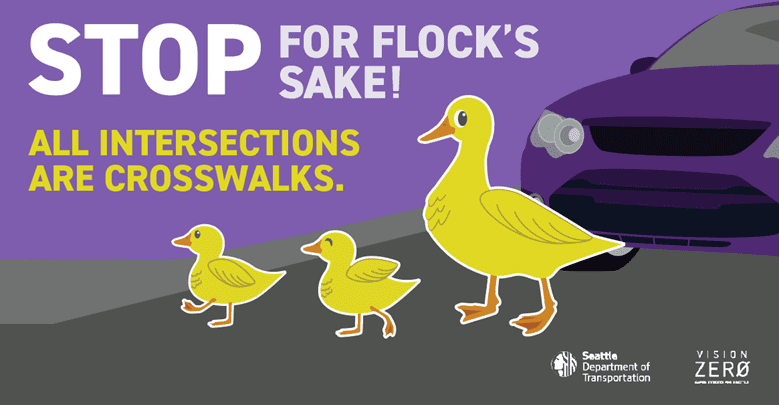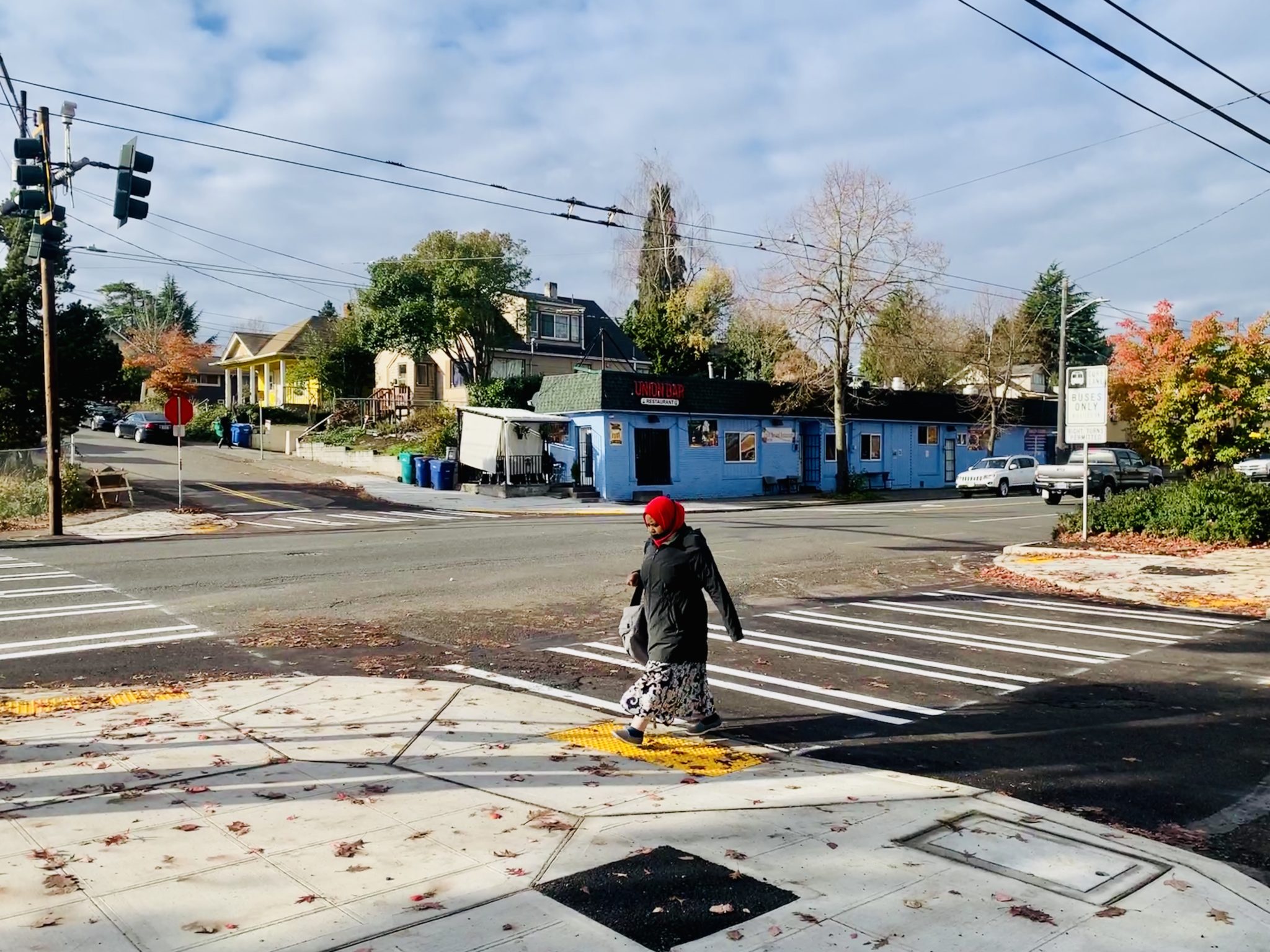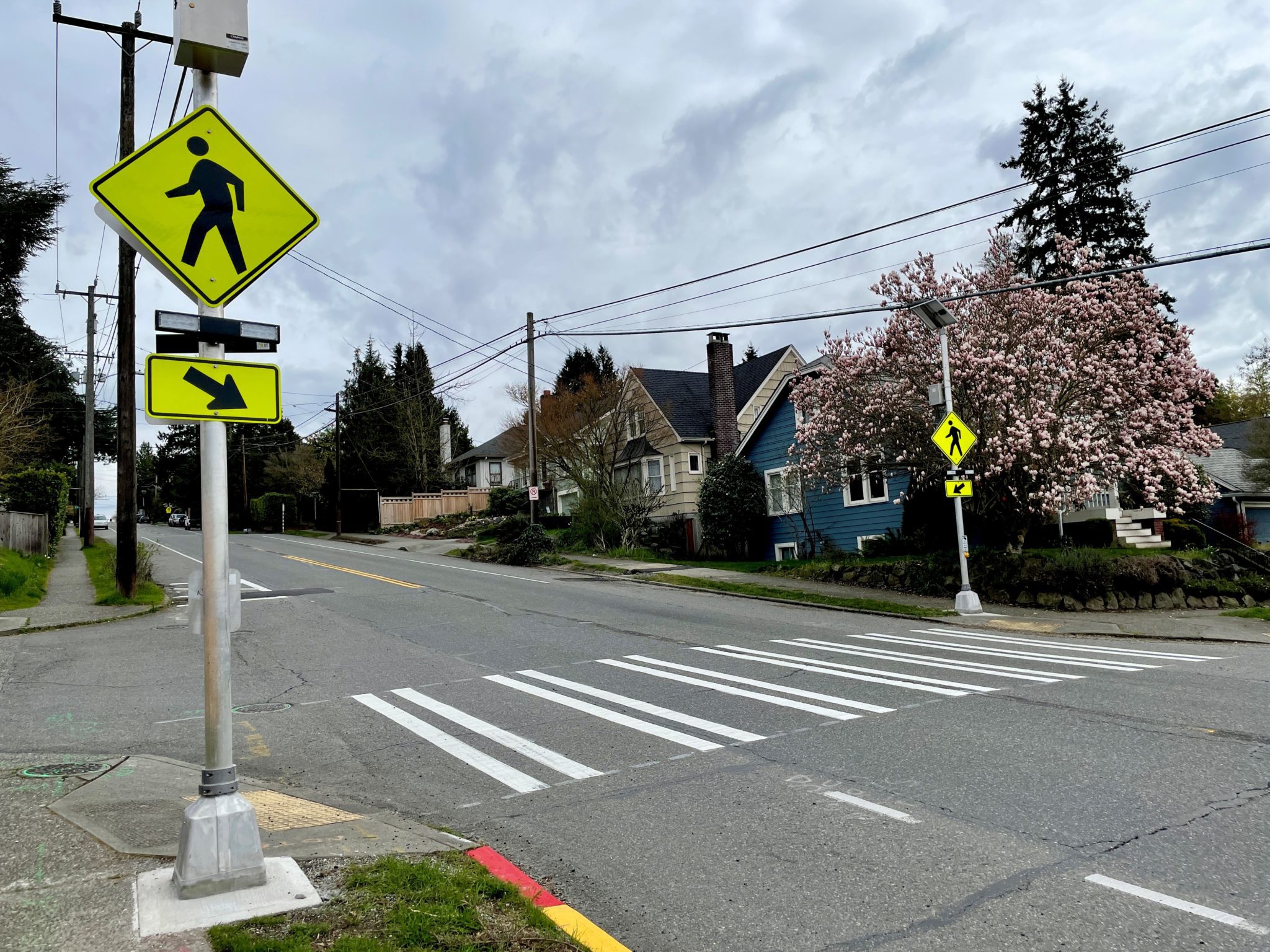 New billboards and ads highlight the importance of stopping for people crossing the street at all intersections. Graphic: SDOT
New billboards and ads highlight the importance of stopping for people crossing the street at all intersections. Graphic: SDOT Summary:
- We’re launching a new set of billboards and ads as part of our grant-funded public safety education and awareness campaign.
- State law specifies that drivers must stop for pedestrians at practically all intersections, whether or not there is a painted crosswalk.
- Through a Safe System approach, we continue to build crosswalks and improve crossing safety throughout the city.
Why did the chicken cross the road? Because every intersection is a crosswalk and the chicken needed to get to the other side!
We’re all members of the larger flock when we travel, and we want everyone to be in the know that pedestrians have the right of way at intersections. Stop for Flock’s Sake so we can all get home to our nests at the end of each day!
To supplement the safety improvements we continue to roll out on Seattle’s streets, we’re continuing our public awareness campaign focused on traveling safely. Earlier in the summer, we launched our “Slow the Flock Down” campaign to emphasize the fact that speed limits have been lowered to 25 miles per hour on most Seattle arterial streets, as part of the City of Seattle’s larger Vision Zero strategy to end traffic deaths and serious injuries by 2030. Our feathered friends are back, but this time with a message to encourage drivers to stop for pedestrians at intersections.
This work is funded by a $250,000 grant from the Washington Traffic Safety Commission which can only be used for public education. This funding is an addition to our Seattle’s Vision Zero budget, which is mostly used to build tangible safety improvements and redesign our streets to be safer for people walking, biking, and rolling.
Per Washington State law, practically all intersections are legal pedestrian crossings, whether or not there is a painted crosswalk, unless a sign officially says that people are not allowed to cross the street in a certain location. That means drivers are legally required to stop for people crossing the street at nearly every intersection in Seattle and throughout the state.
We can all do better, and we’re working to improve awareness — with the ultimate goal of making it safer for people walking and rolling to cross the street. The message is intended for all drivers, especially young males. According to the U.S. Department of Transportation’s Fatality Analysis Reporting System, 72 percent of national traffic deaths in 2020 were males, and 16 to 29 year old males had the highest traffic fatality rate of any demographic group. Unlike the typical language and tone of public service announcements, this campaign uses humor to grab people’s attention with the hope of saving lives.
The U.S. Department of Transportation Federal Highway Administration estimates that 40 percent of pedestrian incidents occur at intersections. Focusing on crossing safety helps us target the most vulnerable travelers in our transportation system that are disproportionately impacted by traffic dangers. Research shows that, as compared to white pedestrians, pedestrians of color wait significantly longer and are passed by more people driving while waiting to cross at crosswalks [please note: you can find additional information in this scholarly article: Racial Bias in Driver Yielding Behavior at Crosswalks (Tara Goddard, 2014, published in the National Institute for Transportation and Communities, with funding from the U.S. Department of Transportation; courtesy of the Portland State University Library)]. Data from the Centers for Disease Control and Prevention reveals that our elderly population is overrepresented in pedestrian traffic fatalities, representing 20% of all pedestrian deaths and only accounting for 17% of the population.
With school starting up again this fall, we also hope that this campaign helps bring drivers’ attention to pedestrian crossings during their morning commutes. Nationally, 10-14% of car trips during morning rush hour are for school travel.
With an emphasis on a Safe System approach that emphasizes our responsibility as a city to design and operate our transportation system in a way that acknowledges and plans for both human error and human frailty, we continue to build crosswalks and improve crossing safety throughout the city.
Through an equity-informed approach to prioritizing projects, our Safe Routes to School program has installed 10 marked crosswalks so far in 2022. We plan to install 29 more marked crosswalks before the end of the year as part of this program.
Also included in the Safe Routes to School program, we installed safety improvements for Wing Luke Elementary. We constructed a mid-block raised crosswalk at S Kenyon St and 37th Ave S. Raised crosswalks provide increased crossing awareness that improve stopping compliance.

To create a safer, more comfortable walking connection to Dunlap Elementary School, we completed several improvements at the intersection of Rainier Ave S and S Rose St, including installing new crosswalks, extending sidewalk corners, and upgrading curb ramps! By the end of 2022, we will replace the existing half signal with a full traffic signal, add left turn lanes, and install a new crosswalk on the north side of the intersection.
We’re currently designing improvements to enhance safety for Cedar Park Elementary School, which includes plans to install new marked crosswalks on both arterial legs of 30th Ave NE & NE 135th St and a new marked crosswalk with a Rectangular Rapid Flashing Beacon (RRFB) on the north side of 35th Ave NE and NE 135th St.


We have been focusing safety improvements in areas that have a high prevalence of incidents and increasing crossing safety where there are high volumes of pedestrians. We’re installing a new crosswalk and pedestrian signal at 24th Ave E and E Lynn St as a part of our 23rd Ave E Vision Zero Project. In combination with a multitude of other safety improvements included in the Route 7 Transit-Plus Multimodal Corridor Project, we are installing a new crosswalk on the north side of the intersection of Rainier Ave S and the I-90 off-ramp. Later this year, as part of the safety improvements on the Melrose Promenade project, we’re installing raised community crosswalks on Melrose Ave at E Pine St and E Pike St, corridors with high pedestrian volumes.

Collision data and equity are two birds of a feather for us in informing crossing safety improvements throughout the city.
Using tools such as our Vision Zero High Injury Network and our Equity Metrics, we’re able to select locations throughout the city that have the greatest need and would benefit the most from safety improvements. With numerous projects working their way towards hatching, we are looking forward to safer streets taking flight.
We will be launching a new portal for community members to determine whether their request for a crossing improvement is likely to be selected based on engineering standards and the City’s prioritization process. Please stay tuned for more updates on this coming soon.
Thank you for your support of safe travel in Seattle, including at crosswalks and intersections throughout the city!